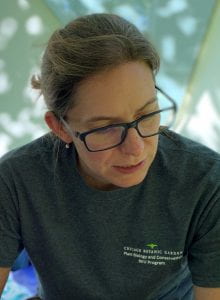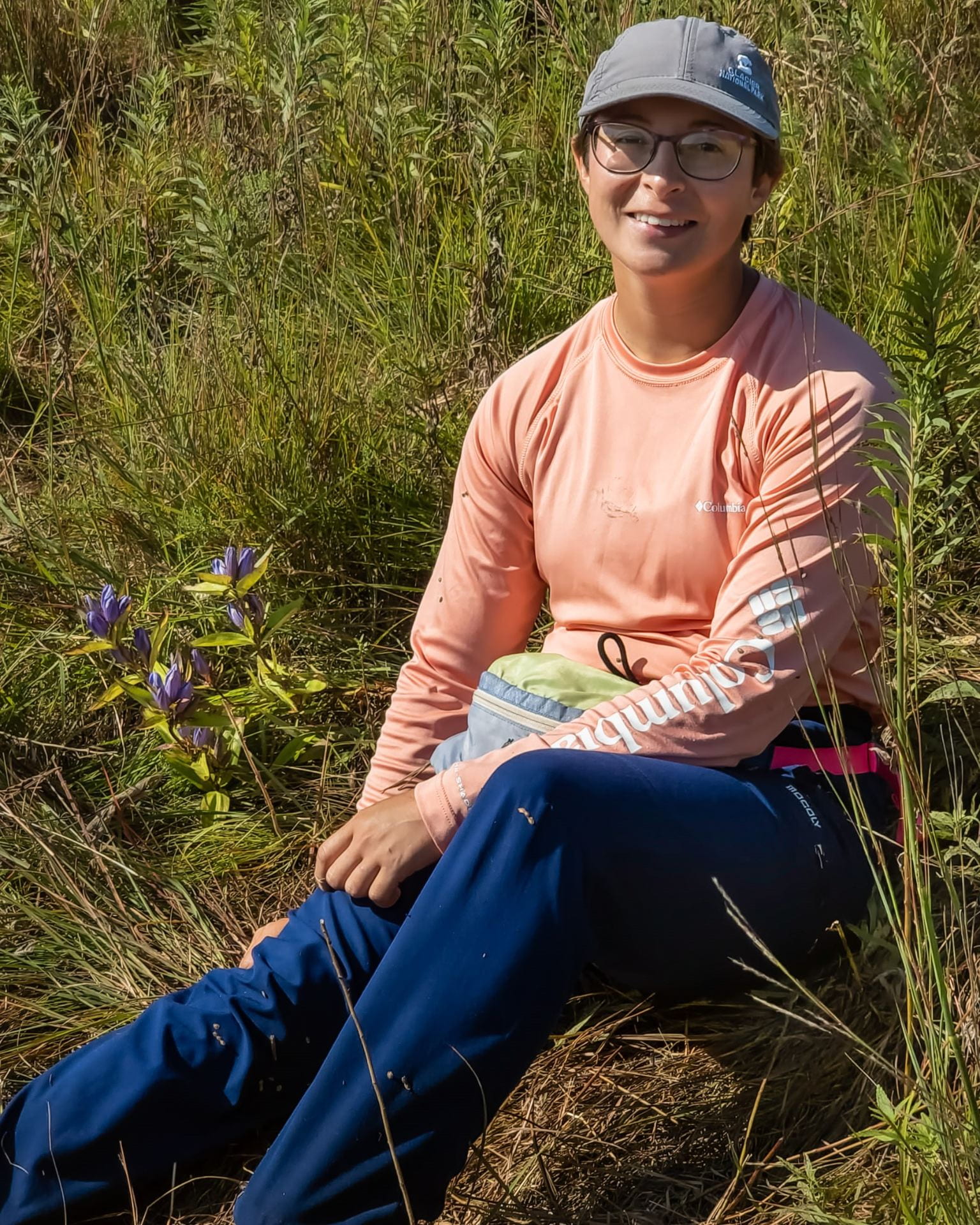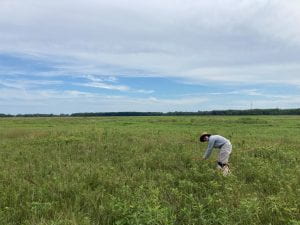Andrea T Kramer (PI): I have been a Conservation Scientist at Chicago Botanic Garden, and adjunct assistant professor at Northwestern University, since 2012, and Director of Restoration Ecology since 2019.
Botanic Garden, and adjunct assistant professor at Northwestern University, since 2012, and Director of Restoration Ecology since 2019.
- I received my PhD from the University of Illinois at Chicago’s Ecology and Evolution program in 2009, advised by Mary Ashley, working closely with committee members Kay Havens and Jeremie Fant.
- I worked as Executive Director of Botanic Gardens Conservation International U.S. from 2008-2012.
- I worked as a research intern and research assistant at Chicago Botanic Garden from 2000-2003.
- I received my BA from Macalester College in 2000, advised by Mark Davis and working as a research intern with him at the Cedar Creek LTER site for two summers.
Current
Emma Fetterly (MS student, co-advised with Jeremie Fant): Emma’s thesis research is exploring abiotic drivers and genetic consequences of floral color polymorphism in Castilleja coccinea (Orobanchaceae).
 Melissa Duda (MS student, c0-advised with Jeremie Fant): Melissa’s thesis research focuses on using reproductive biology and ecological niche models to predict the potential impact of hybridization in rare species. She will explore this issue in Gentiana puberulenta, a dry prairie species considered rare in portions of its range, and Gentiana andrewsii, a more common congener that grows in mesic prairies. She was introduced to their hybrid, Gentiana x billingtonii, while volunteering in McHenry County and has been intrigued ever since. Her thesis research aims to identify the reproductive mechanisms and ecological conditions promoting hybridization in rare species to better understand the potential risk of extinction or evolutionary benefit Gentiana x billingtonii may pose. She enjoys volunteering for Plants of Concern, monitoring Cirsium hilli and Utricularia intermedia at the Lake in the Hills Fen.
Melissa Duda (MS student, c0-advised with Jeremie Fant): Melissa’s thesis research focuses on using reproductive biology and ecological niche models to predict the potential impact of hybridization in rare species. She will explore this issue in Gentiana puberulenta, a dry prairie species considered rare in portions of its range, and Gentiana andrewsii, a more common congener that grows in mesic prairies. She was introduced to their hybrid, Gentiana x billingtonii, while volunteering in McHenry County and has been intrigued ever since. Her thesis research aims to identify the reproductive mechanisms and ecological conditions promoting hybridization in rare species to better understand the potential risk of extinction or evolutionary benefit Gentiana x billingtonii may pose. She enjoys volunteering for Plants of Concern, monitoring Cirsium hilli and Utricularia intermedia at the Lake in the Hills Fen.
Jacob Zeldin (MS 2017, now Research Ecologist and PhD student): Jacob’s MS thesis  research investigated functional composition in prairie plant communities and implications for invasion resistance, restoration, and conservation. He currently works to develop micropropagation protocols and manage a microprop lab for native species commonly used in restoration activities to support conservation and ecological research. He is also working on a project to investigate intraspecific variation in functional traits in numerous forb species commonly used in restoration, and supports data analysis and visualization work for numerous other ongoing projects. This work has led to a collaborative project New Roots for Restoration that is the focus of his PhD research.
research investigated functional composition in prairie plant communities and implications for invasion resistance, restoration, and conservation. He currently works to develop micropropagation protocols and manage a microprop lab for native species commonly used in restoration activities to support conservation and ecological research. He is also working on a project to investigate intraspecific variation in functional traits in numerous forb species commonly used in restoration, and supports data analysis and visualization work for numerous other ongoing projects. This work has led to a collaborative project New Roots for Restoration that is the focus of his PhD research.
Zeldin, J., Lichtenberger, T., Foxx, A., Williams, E.R., Kramer, A.T. 2020. Intraspecific functional trait structure of restoration-relevant species: implications for restoration seed sourcing. Journal of Applied Ecology
Erin Snyder (MS student, co-advised with Becky Barak). Erin is interested in restoration, novel ecosystems, urban ecology, and community science. Her research explores the impact of seed source on seed germination and plant establishment to test a habitat analog restoration model for former steel industry sites in Chicago. Specifically, Erin studies whether slag can support dolomite prairie species and, if so, guide seed source selection for restoration in post-industrial landscapes.
ecosystems, urban ecology, and community science. Her research explores the impact of seed source on seed germination and plant establishment to test a habitat analog restoration model for former steel industry sites in Chicago. Specifically, Erin studies whether slag can support dolomite prairie species and, if so, guide seed source selection for restoration in post-industrial landscapes.
Angela McEnerney (MS student, co-advised with Louise Egerton-Warburton). Angela is investigating mycorrhizal and soil moisture limitations to the restoration of Viola sagitatta on former agricultural land at Kankakee Sands. Specifically, Angela’s project uses high-throughput sequencing to document arbuscular mycorrhizal fungi (AMF) community responses to seasonal shifts in soil moisture in remnant and restored prairies. She is then experimentally testing AMF’s functional role in seedling survival and growth Viola sagitatta under different drought scenarios projected with climate change in the Midwest. This violet species is a primary larval host for the rare Regal Fritillary butterfly and has been the target of (largely unsuccessful) restoration efforts in the region for more than a decade.
Rafael Urbina- Casanova (PhD student – co-advised with Jeremie Fant): Rafael is interested in  conservation of endangered plant species. His research focuses on the influence of genetics on extirpation of small plant populations, and how augmenting genetic diversity and/or decreasing inbreeding could help to improve their conservation status. He is also interested in restoration ecology, and how restoration practice could include rare species, broadening its conservation outcomes. His background includes endemism, phylogenetics, conservation assessment and planning, biodiversity monitoring, and environmental impact assessment of flora and vegetation.
conservation of endangered plant species. His research focuses on the influence of genetics on extirpation of small plant populations, and how augmenting genetic diversity and/or decreasing inbreeding could help to improve their conservation status. He is also interested in restoration ecology, and how restoration practice could include rare species, broadening its conservation outcomes. His background includes endemism, phylogenetics, conservation assessment and planning, biodiversity monitoring, and environmental impact assessment of flora and vegetation.
Alumni
 Alexis Balog (MS student): Alexis worked with collaborators at the Forest Preserves of Cook County to test different management approaches for tall goldenrod (Solidago altissima), an aggressive native species that often displaces other native species, particularly at disturbed sites. She tested whether mowing, seeding native species, or a combination of the two treatments impacted tall goldenrod at two grassland sites with different management histories.
Alexis Balog (MS student): Alexis worked with collaborators at the Forest Preserves of Cook County to test different management approaches for tall goldenrod (Solidago altissima), an aggressive native species that often displaces other native species, particularly at disturbed sites. She tested whether mowing, seeding native species, or a combination of the two treatments impacted tall goldenrod at two grassland sites with different management histories.
Marcello De Vitis (postdoctoral researcher 2020-2021):  Marcello worked with Kay Havens and me, as well as a collaborator at Ball Horticultural Company, to understand genetic and environmental controls on seed germination in native species of Viola. He also worked with collaborators at Kankakee Sands Preserve to understand what factors may improve the reintroduction of native Viola species to areas that have undergone restoration. Marcello is now Director of Seeds of Success for the Southeastern Grasslands Initiative.
Marcello worked with Kay Havens and me, as well as a collaborator at Ball Horticultural Company, to understand genetic and environmental controls on seed germination in native species of Viola. He also worked with collaborators at Kankakee Sands Preserve to understand what factors may improve the reintroduction of native Viola species to areas that have undergone restoration. Marcello is now Director of Seeds of Success for the Southeastern Grasslands Initiative.
PUBLICATION: De Vitis et al. Why are some plant species missing from restorations? A diagnostic tool for temperate grassland ecosystems. Frontiers in Conservation Science
Adrienne Ernst (PhD 2021): Adrienne’s PhD research focused on the impact of phylogenetic diversity on invasibility of prairie ecosystems. Much of her research took place at the Morton Arboretum’s prairie plots. After graduations she was a postdoctoral fellow in Karin Kettenring’s lab at Utah State University studying social-ecological management of invasive species, and she is now an Assistant Professor at Berry College.
on invasibility of prairie ecosystems. Much of her research took place at the Morton Arboretum’s prairie plots. After graduations she was a postdoctoral fellow in Karin Kettenring’s lab at Utah State University studying social-ecological management of invasive species, and she is now an Assistant Professor at Berry College.
PUBLICATION: Ernst, Barak; Hipp; Kramer; Marx; Larkin. (2021) The invasion paradox dissolves when using phylogenetic and temporal perspectives. Journal of Ecology.
Alicia Foxx (MS 2014, PhD 2020): Alicia’s MS and PhD research focused on plant coexistence and  genetic variation and phenotypic plasticity in root functional traits within species, with applications to restoration ecology. Her study species included priority restoration forb species native to the Colorado Plateau. After two years as a SCINet Postdoctoral Fellow at the USDA’s Genomics and Bioinformatics Research Unit and we are thrilled that she has returned to Chicago Botanic Garden as a Conservation Scientist and is a collaborator on the Biology Integration Institute New Roots for Restoration.
genetic variation and phenotypic plasticity in root functional traits within species, with applications to restoration ecology. Her study species included priority restoration forb species native to the Colorado Plateau. After two years as a SCINet Postdoctoral Fellow at the USDA’s Genomics and Bioinformatics Research Unit and we are thrilled that she has returned to Chicago Botanic Garden as a Conservation Scientist and is a collaborator on the Biology Integration Institute New Roots for Restoration.
PUBLICATION: Foxx AJ, Kramer AT (2021) Hidden variation: cultivars and wild plants differ in trait variation with surprising root trait outcomes. Restoration Ecology:e13336.
PUBLICATION: Foxx AJ, Kramer AT (2020) Variation in number of root tips influences survival in competition with an invasive grass. Journal of Arid Environments 179:104189
Matt Evans (MS 2020): Matt worked with collaborators at the Shedd Aquarium to investigate the  restoration of vernal pools in local forest preserves. Specifically, he asked whether a soil seed bank of desirable native species persists in vernal pools invaded by buckthorn, and whether seeding is a necessary part of any restoration efforts in this habiat. This blog post explains the background for his research project. He is now Managing Ecologist, Woodlands at Chicago Botanic Garden
restoration of vernal pools in local forest preserves. Specifically, he asked whether a soil seed bank of desirable native species persists in vernal pools invaded by buckthorn, and whether seeding is a necessary part of any restoration efforts in this habiat. This blog post explains the background for his research project. He is now Managing Ecologist, Woodlands at Chicago Botanic Garden
Sam Kilgore (MS 2020): Sam worked with collaborators at Ball Horticultural Company to investigate the seed ecology of native Viola species. The goal is to understand germination and storage requirements for th ese important native species so they can be more easily, affordably, and effectively incorporated in restoration activities. He is now Land Stewardship Manager and Native Plant Specialist at The Conservation Foundation.
ese important native species so they can be more easily, affordably, and effectively incorporated in restoration activities. He is now Land Stewardship Manager and Native Plant Specialist at The Conservation Foundation.
PUBLICATION: Kilgore S, Havens K, Kramer AT, Lythgoe A, Mackechnie L, Vitis MD (2021) Seed collection, storage, and germination practices may impact Viola reintroduction outcomes. Native Plants Journal
Taran Lichtenberger (MS 2020): Taran investigated the impact of genotypic and functional trait diversity on productivity in a priority restoration forb species (Machaeranthera canescens). Taran is now the Budburst Community Engagement Manager.
Katie Kucera (MS 2020): Katie worked with partners at the USDA Forest Service and the Utah Division of Wildlife Resources to characterize genetic changes in the production of multi-source seed lots in Penstemon pachyphyllus in the Great Basin, USA. After serving as the Plants of Concern Research Assistant and the Administrative Manager of the Friends of the Illinois Nature Preserves, she is now an Ecologist with The Wetlands Initiative.
PUBLICATION: Kucera KF, Fant JB, Jensen S, Landeen M, Orr E, Kramer AT (2021) Genetic variation and structure change when producing and using mixed-source seed lots for restoration. Restoration Ecology
Nathan Lamb (MS 2018): Nathan’s research identified low restoration potential of soil seed banks in buckthorn-invaded oak woodlands in forest preserves of the Chicago region. After working as Assistant Director and Curator at the Heronswood Garden on Bainbridge Island, WA, Nathan moved back to Rhode Island and owns his own business, Gardening + Ecology.
PUBLICATION: Lamb N, Havens K, Holloway J, Steffen JF, Zeldin J, Kramer AT (2021) Low passive restoration potential following invasive woody species removal in oak woodlands. Restoration Ecology
Evelyn Williams (post-doc and adjunct conservation scientist 2015-2018): Evelyn worked on understanding the impact of genetic diversity on outcomes of restoration and conservation at multiple scales. She is now a Restoration Ecologist at Adaptive Restoration.
Abbey White (MS 2017, co-advised with Jeremie Fant): Abbey’s research focused on assessing capacity of the US native plant industry to support the restoration of species diversity. This included developing a nationwide dataset of vendors and the native plants they sell. She also investigated the conservation genetics of a rare thistle species endemic to gravel hill prairies in the Chicago region (Cirsium hillii). Abbey is now the on-site naturalist at Forest Bluff School.
PUBLICATION: White, A., J.B. Fant, K. Havens, M. Skinner, and AT. Kramer (2018) Restoring species diversity: assessing capacity in the US native plant industry. Restoration Ecology 26(4): 605–611.
Alex Seglias (MS 2017): Alex investigated the impact of phylogeny and source climate on seed dormancy and germination in restoration-relevant forb species, as well as how storage impacts dormancy behavior in these species. Alex is now a seed conservation researcher at Denver Botanic Gardens.
PUBLICATION: Seglias, A., A. Bilge, E. Williams, and A. T. Kramer. 2018. Phylogeny and source climate impact seed dormancy and germination of restoration-relevant forb species. PLoS ONE
PUBLICATION: Seglias A, Finch J, Kramer AT (2020) Germination behaviour of forbs native to the southwestern United States following exposure to short-term seed bank conditions (−20°C). Seed Science Research 30:81 – 91
Chris Woolridge (MS 2017, co-advised with Jeremie Fant): Chris investigated appropriate seed sourcing for ecological restoration in light of climate change. He conducted a common garden experiment comparing the fitness of five tallgrass prairie species among commercial sources across a latitudinal gradient. Chris is now the Garden’s Conservation and Land Management Internship Senior Program Manager, Conservation Training.
Adrienne Basey St. Clair (MS 2015, co-advised with JF): Working with collaborators at the Institute for Applied Ecology and the University of Washington, Adrienne investigated changes in genetic diversity when a wild plant is brought into cultivation to create multi-source seed lots for reintroduction. Her study species was golden paintbrush (Castilleja levisecta), a threatened species native to the prairies of western Oregon and Washington, which is being used in number of reintroductions. Adrienne is now assistant plant materials scientist at Portland Metro’s Native Plant Center
PUBLICATION: Basey, A. C., J. B. Fant, and A. T. Kramer. 2015. Producing native plant materials for restoration: ten rules to collect and maintain genetic diversity. Native Plants Journal 16:37-53. A
PUBLICATION: St. Clair, A.B., Dunwiddie, P.W., Fant, J.B., Kaye, T.N., Kramer, A.T. (2020). Mixing source populations increases genetic diversity of restored rare plant populations. Restoration Ecology, online early.
Nora Talkington (MS 2015, research assistant 2015-2016): Nora investigated trait variation between populations of Sporobolus airoides and implications for restoring invaded grasslands. She also worked as a research assistant, helping to build the Colorado Plateau Restoration Outcomes dataset. Nora now works as the Navajo Natural Heritage Program Botanist in Flagstaff, Arizona.
Maggie Eshleman (MS 2015): Maggie investigated intraspecific variation in early life history characteristics of native Colorado Plateau forb species. As a part of this she worked with REU student Lisa Hintz on a summer research project investigating when seed sourcing matters on the Colorado Plateau. Maggie now works as a restoration scientist with the Wyoming chapter of The Nature Conservancy.
PUBLICATION: Hintz, L., A. Foxx, M. Eshleman, T. E. Wood, and A. T. Kramer. 2016. Population differentiation in early life history traits of Cleome lutea var. lutea in the Intermountain West. Western North American Naturalist 76:6-17.